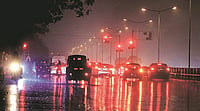Monsoon's Departure
The monsoon's withdrawal marks a significant shift in the weather patterns of Bengaluru and the surrounding regions. After bringing consistent rainfall
for several months, the monsoon season is now gradually retreating. Meteorological experts have predicted that this retreat will bring about isolated heavy showers across these areas. This is a normal transition as the atmospheric conditions change, influencing the types of weather events the region can expect. The withdrawal process doesn't occur uniformly; it often involves periods of fluctuating rainfall, with intense spells followed by drier intervals, especially near the end of the monsoon season. Understanding this pattern is crucial for residents to prepare for the changing conditions.
Heavy Showers Forecast
The forecast specifically mentions the likelihood of isolated, heavy showers in Bengaluru and the districts around it. The term 'isolated' suggests that these showers will not be widespread across the entire region; some areas may experience heavy rainfall, while others might remain relatively dry. The intensity of these showers is a key factor; 'heavy' implies a significant amount of rainfall within a short period. This can lead to temporary waterlogging, especially in urban areas with inadequate drainage systems. Residents should be aware of these potential hazards and take appropriate precautions. Furthermore, these localized heavy showers are often linked to the localized atmospheric conditions, such as the development of convective clouds that can quickly bring intense rainfall.
Anticipating Weather Changes
As the monsoon winds down, the weather patterns are in a state of flux. The transition period is frequently characterized by unpredictable weather. The isolated, heavy showers are a part of this pattern. These rapid shifts in weather are likely to impact daily routines. The fluctuations in temperature and humidity can be noticeable. It's advisable to stay updated on weather forecasts. Local news sources and weather apps can provide timely alerts about expected rainfall and potential disruptions. Planning outdoor activities becomes essential as the risk of sudden downpours increases. Taking precautionary measures, such as carrying an umbrella or rain gear, will become important.
Meteorological Explanations
Several meteorological factors contribute to the occurrence of heavy showers during the monsoon's withdrawal. Changes in wind patterns, air pressure systems, and the presence of moisture in the atmosphere all play a role. As the monsoon retreats, the prevailing winds start to shift. This may trigger localized atmospheric disturbances. These disturbances can lead to the formation of convective clouds capable of producing intense rainfall. The interaction between different air masses also becomes important. Furthermore, the remaining moisture in the air from the monsoon period provides fuel for these showers. The combination of these elements increases the likelihood of heavy, isolated rainfall events.
Preparing for Showers
In anticipation of the predicted heavy showers, there are several steps that residents can take to prepare and reduce potential inconvenience. Ensure that your homes are properly prepared. It is essential to check the drainage systems. Inspecting the gutters and downspouts can help ensure that water drains efficiently. Parking vehicles in covered locations can protect them from potential damage. Keep an emergency kit ready with essential supplies. Staying informed about the latest weather updates is crucial. Weather apps, local news channels, and online resources will provide warnings regarding the severity and timing of the showers. By taking these simple actions, residents can minimize the impact of the approaching heavy rainfall.











